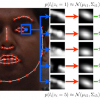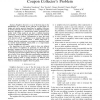20 search results - page 3 / 4 » Improving the Efficacy of a Termination Detection Algorithm |
ICML
2009
IEEE
14 years 8 months ago
2009
IEEE
An anytime algorithm is capable of returning a response to the given task at essentially any time; typically the quality of the response improves as the time increases. Here, we c...
VTC
2007
IEEE
14 years 1 months ago
2007
IEEE
—This paper presents a novel strategy for interference mitigation in an uplink of high reuse cellular networks through distributive processing. It is proposed that the neighborin...
KES
2006
Springer
13 years 7 months ago
2006
Springer
The issue of Automatic Relevance Determination (ARD) has attracted attention over the last decade for the sake of efficiency and accuracy of classifiers, and also to extract knowle...
ICCV
2009
IEEE
15 years 14 days ago
2009
IEEE
Local experts have been used to great effect for fitting deformable
models to images. Typically, the best location in
an image for the deformable model’s landmarks are found
t...
MOBICOM
2009
ACM
14 years 2 months ago
2009
ACM
—Neighbor discovery1 is one of the first steps in the initialization of a wireless ad hoc network. In this paper, we design and analyze practical algorithms for neighbor discove...


